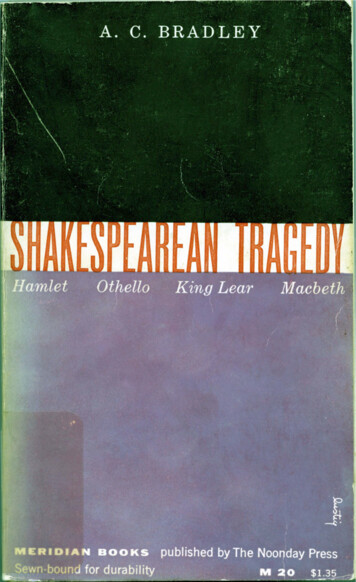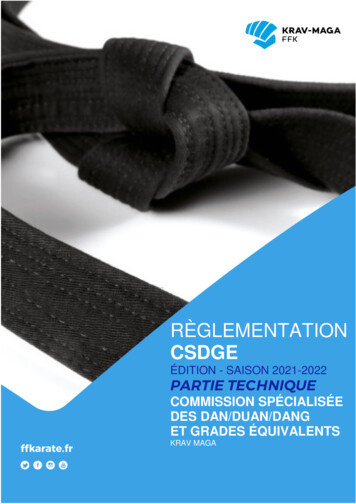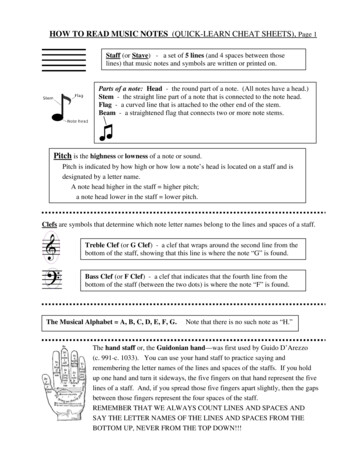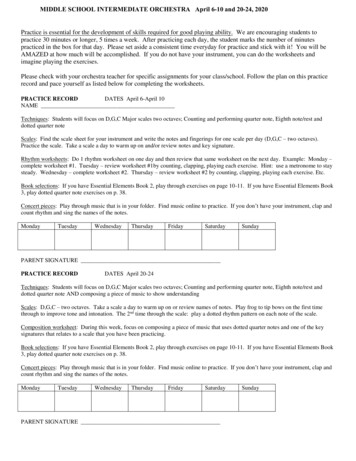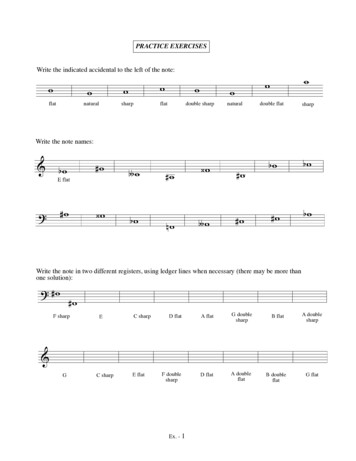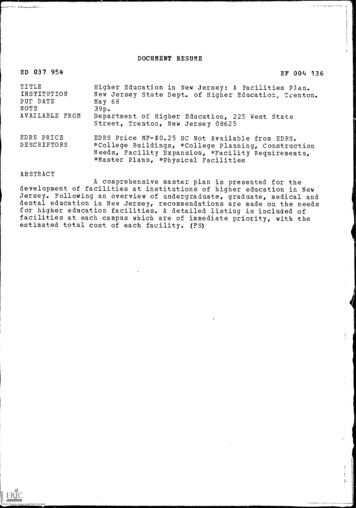
Transcription
DOCUMENT RESUMEED 037 954EF 004 136TITLEINSTITUTIONpur DATENOTEAVAILABLE FROMHigher Education in New Jersey: A Facilities Plan,New Jersey State Dept. of Higher Education Trenton.May 68EDRS PRICEDESCRIPTORSEDRS Price MF- 0.25 HC Not Available from EDRS.*College Buildings, *College Planning, ConstructionNeeds, Facility Expansion, *Facility Requirements,*Master Plans, *Physical Facilities39p.Department of Higher Education, 225 West StateStreet, Trenton, New Jersey 08625ABSTRACTA comprehensive master plan is presented for thedevelopment of facilities at institutions of higher education in NewJersey. Following an overview of undergraduate, graduate, medical anddental education in New Jersey, recommendations are made on the needsfor higher education facilities. A detailed listing is included offacilities at each campus which are of immediate priority, with theestimated total cost of each facility. (FS)
1U,S, DEPARTMENT OF HEALTH, EDUCATION& WELFAREOFFICE OF EDUCATIONTHIS DOCUMENT HAS BEEN REPRODUCEDEXACTLY AS RECEIVED FROM THE PERSON ORORGANIZATION ORIGINATING IT POINTS OFVIEW OR OPINIONS STATED DO NOT NECESSARILY REPRESENT OFFICIAL OFFICE OF EDUCATION POSITION OR POLICY---illianthalMe2.01i,Z."\004.,
t/-ares.J 212
HIGHER EDUCATION IN NEW JERSEY: A FACILITIES PLANThe Higher Education Act of 1966 established theBoard of Higher Education and gave it responsibilityfor overseeing and planning the development of highereducation in the state. The Act also created the Department of Higher Education to carry out the policiesof the Board.The Board has recognized as a major responsibilitythe need to prepare a comprehensive master plan forhigher education. On the basis of data and analysisdeveloped by Heller Associates, the Board is presenting in this document a master plan for the developmentof facilitiesclassrooms, laboratories, libraries, gymnasiums and dormitories. The Board has given priorityattention to planning for additional facilities becauseof the great need and the long period required forconstruction.Two years ago the Citizens Committee for HigherEducation, composed of leading citizens fromthroughout the state, concluded in its influential study,"A Call To Action", that higher education was in astate of crisis and that massive state expenditures foradditional classrooms, laboratories and other facilitiesmust be made immediately if New Jersey's future asa wealthy industrial state is to be secure. The soberingfacts which persuaded the Citizens Committee areeven more true today:estimate remains accurate today. Large capital investments must be undertaken immediately if thesestudents are to be given their fair chance to attendcollege.Even with determination, the problem of facilities cannot be solved quickly. To build buildings takes time.Three to four years are required from the day fundsfor a classroom building become available until students attend classes. Complex research facilities maytake even longer.New Jersey has over the last few years prepared theframework for a iligher education system of the sizeand quality reqto serve the citizens of our state.The first section of this docurrnt describes that system and the promise it embodies.But a major effort and considerable sums of moneyare needed if that promise is to be fulfilled. It is therefore with a sense of great urgency that the Board ofHigher Education presents the facilities plan in thelater sections of this document. We believe that todelay its implementation would be irresponsible andinvolve great risks, not only to our young men andwomen who must have opportunity to obtain the bestpossible college education, but also to the state as awhole because its place in the American economyand culture is vitally dependent on the education of"A Call to Action" pointed out that 55% of ourundergraduate students attend college in otherits people.states. Today 54% go out-of-state. Only Alaska exports a higher percentage."A Call to Action" reported that New Jersey was48th among the 50 states in per-capita expendituresEDWARD E. BOOHER,ChairmanMRS. JOHN H. FORD,Vice ChairmanWILLIAM 0. BAKERJOHN T. CONNORC. DOUGLAS DILLONDONALD C. LUCEV. D. MATTIAWILLIAM H. McLEANon higher education. Today we are 50th. Everyother state spends more per-capita."A Call to Action" demonstrated that some 220,000qualified New Jersey students would be seeking anopportunity to attend college full-time in 1975. ThatEDWARD J. MEADE, JR.W. KABLE RUSSELLJGHN M. SEABROOKGEORGE F. SMITHDR. DEBORAHCANNON WOLFEFREDERICK 0. ZIEGLERRALPH A. DUNGAN(Ex-Officio)CARL L. MARBURGER(Ex-Officio)
RSTATECOLLEGEJERSEY CITYSTATECOLLEGERUTGERS UNIVERSITYSOMERSETCOUNTYCOLLEGENEWARK COLLEGE EX COUNTY LLEGE/'./,."t.,,,, j.iY\\\\)'7--%,,MONMOOTHCOUNTY COMMUNITYCOLLEGESEANLI ,,LNEW JERSEY COLLEGEOF MEDICINE ITYCOLLEGE
NEW JERSEYHIGHER EDUCATIONAN EVOLVINGSYSTEMThe public institutions of higher learning in NewJersey are:.Rutgers, the State Universitythe Newark College of Engineeringthe New Jersey College of Medicineand Dentistrythe State Collegesand the Community Colleges.Under the Higher Education Act of 1966, the roleof the Board of Higher Education is set forth asfollows:"It shall be the duty of the Board of Higher Edu-cation to advance long-range planning for thesystem of higher education as a whole in thestate; establish general policy for the governanceof the separate institutions; co-ordinate theactivities of the individual institutions which,taken together, make up the system of highereducation in New Jersey; and maintain generalfinancial oversight of the state system of highereducation."Within this clearly defined framework, the Boardhas assumed its duties and has acted to carry outthe mandates of the Higher Education Act.Rutgers, The State UniversityRutgers University is one of the oldest institutionsof higher learning in the country. In perspective andcommitment, however, it is among the most modern. Through diversified undergraduate and gradu-ate programs, in research and in communityservice, the University serves the people of theentire state.Rutgers was founded in 1766 as Queen's College.A century later, it was designated a land-grantinstitution. By act of the Legislature in 1945, it be-came the State University of New Jersey, and in1956 control was vested in a Board of Governorshaving a majority of public members.The main campus of Rutgers University is inNew Brunswick. Other campuses are in Newarkand Camden. Thus the University directly servesthe central, northern, and southern sections of thestate. Its enrollment consists of nearly 13,500 fulltime undergraduate students, 2,700 full-time graduate students, and almost 9,700 part-time students.3
The principal divisions of Rutgers University include:descendant of Queen's College), tho College ofAgriculture and Environmental Science, the Col-As one of the two medical schools of the state,the New Jersey College of Medicine and Dentistryplays an important role, not only in training neededdoctors and dentists but also in providing leadership in improving medical care for all citizens oflege of Engineering, Douglass College (forNew Jersey.The College of Arts and Sciences (the directwomen), University College (for part-time students), Newark College of Arts and Sciences, theCollege of Pharmacy, the College of Nursing,and the College of South Jersey.The Schools of Law in Newark and Camden.The Medical School (presently providing a twoyear curriculum but with plans for becoming afour-year school of medicine).The Graduate School (offering programs in various specialized fields), The Graduate School ofEducation, The Graduate School of LibraryScience, the Graduate School of Social Work,and the Graduate School of Business Administration.Newark College of EngineeringNewark College of Engineering, one of the nation'sleading engineering schools, was founded in 1881as the Newark Technical School. It was designateda College of Engineering in 1919. Over the years,financial support has shifted from the city ofNewark to the state. The college is governed by aBoard of Trustees appointed by the Governor.The college is located on a 20-acre campus nearthe heart of downtown Newark.Its five principal divisions are Day Undergraduate, Evening Undergraduate, Graduate, Technol-The University Extension Division, the Eagletonogy, and Continuing Engineering Studies. ItsInstitute of Politics, the Urban Studies Center,Bachelor of Science programs are in chemical, civil,the Institute of Microbiology, the Radiationelectrical, industrial, and mechanical engineering.There are Master of Science programs in the samespecialities, and Doctor of Engineering Scienceprograms in chemical, electrical, and mechanicalScience Center, The Center for Alcohol Studies,and the Interdisciplinary Research Center.In addition, there is Livingston College, a co-educational liberal arts college now under construction onthe former Camp Kilmer site and scheduled to openin the fall of 1969. This new college will place spe-cial emphasis on attracting and educating disadvantaged students and on urban studies.New Jersey College of Medicine and DentistryMedical and dental training was not available in thestate until 1954. In that year Seton Hall Universityestablished a college of medicine and dentistry inJersey City. In 1964, for financial reasons, SetonHall asked the state to take over the college. Aftercareful review, the state assumed responsibility in1965. The institution was renamed the New JerseyCollege of Medicine and Dentistry and placed un-der the administration of a Board of Trusteesappointed by the Governor, with the advice andconsent of the Senate.Present enrollment at the College is 490 students.The College is currently in the process of planning and developing a new campus in Newark. TheNewark campus will include a new teaching hospital. Programs are planned so as to involve the College closely in the life of the community.engineering.Newark College of Engineering also offers non-degree programs for training engineering technicians.Its enrollment consists of nearly 2,700 full-timeundergraduates, 79 full-time gradtte students andover 2,100 part-time students.The importance of maintaining a public engineering college of the highest quality in our heavilyindustrialized state cannot be over-emphasized.
The State CollegesThere are six State Colleges: Glassboro, JerseyCity, Montclair, Newark, Paterson and Trenton.Newark and Paterson were established as citynormal schools in 1855, the same year that Trentonwas established as the New Jersey State Normaland Model School. Montclair and Glassboro beganas two-year normal schools in 1908 and 1923,respectively, and Jersey City was established in1929 as a New Jersey State Normal School offeringthree-year programs.All six evolved into four-year State Teachers Colleges, and in 1958 each was formally designated a"State College". But they continued to function assingle-purpose teacher training institutions.In passing the Higher Education Act of 1966, theLegislature directed their transition to multi-purpose institutions:"State Colleges shall be maintained for the purpose of providing higher education in the liberalarts and sciences and various professional areasincluding the science of education and the art ofteaching at such places as may be provided bylaw."The Board of Higher Education and the collegesacted promptly to carry out this legislative mandate.The State Colleges offer both undergraduate andgraduate programs and currently enroll more than20,700 full-time undergraduates. They also enroll143 full-time graduate students and over 22,300part-time students.The colleges formerly were under the centralcontrol of the State Department of Education. TheHigher Education Act substituted control by ninemember Boards of Trustees. The appointment ofBoards of Trustees was given the highest priorityby the Board of Higher Education, and since thefirst of this year these Boards have been playinga,live roles in the planning and administration ofthy; colleges.The Community CollegesLegislation authorizing the establishment of twoyear community colleges was enacted in 1962. Withboth state and county financial support, the development of a statewide network of community col-leges has been rapid. Public enthusiasm for thesenewest additions to the public system of higher edu-cation has clearly demonstrated that a vital needis being met.This is the current status of the community college program:IN OPERATIONGRADUATING FIRST STUDENTS IN JUNE 1968Atlantic Community CollegeCumberland County CollegeMercer County Community CollegeMiddlesex County CollegeOcean County CollegeIN OPERATIONGRADUATING FIRST STUDENTS IN JUNE 1969Camden County CollegeBEGINNING OPERATION IN SEPTEMBER 1968Bergen Community CollegeEssex County CollegeGloucester County CollegeMonmouth County Community CollegeMorris County CollegeSomerset County CollegeBEGINNING OPERATION IN SEPTEMBER 1969Burlington County College
VW.3v.
With the opening of six more colleges this September, approximately 10,000 full-time studentswill be attending the community colleges. It may beassumed that many if not most of these studentswould have been denied college opportunities hadthere been no community college program.The community colleges offer both career pro-grams and two-year transfer programs. The latterare predicated on the availability of spaces in fouryear institutions for the junior and senior year. Insupporting and encouraging the development ofcommunity colleges, the state has assumed an obligation to provide further opportunities for thosestudents who successfully complete the two-yeartransfer programs.Each community college is governed by a nine-member Board of Trustees appointed by thecounty's Boards of Freeholders. The state providesup to 50% of the capital and operating costs of thecommunity colleges.The Independent Colleges and UniversitiesNo discussion of higher education would be complete without recognizing the important role of theindependent institutions. These colleges and universities are currently educating 33,000 full-timeundergraduates (of whom 23,900 are New Jerseystudents) and over 3,400 full-time graduate students. More than 24,000 part-time students are alsoenrolled. In every sector the independent institutions are making an important contribution to thestrength and vigor of higher education in Neware professional and technologir,a1 colleges; andfour are universities.It is in the public interest that these independentcolleges and universities remain strong. Not onlydo these institutions contribute to the diversity ofhigher education in our state; they also fulfill a vitalsocial role in providing higher education facilitiesfor more than one-third of New Jersey undergraduates now enrolled within the state.Prospects for the FutureNew Jersey's system of public higher education is,from a certain standpoint, quite new. Although itsbackground can be traced back to the Queen's Col-lege of colonial times, its present structure is ofrecent origin.Rutgers was not designated the State Universityuntil after World War II. Development of the com-munity college system began only in 1962. TheNew Jersey College of Medicine and Dentistry didnot become a state supported institution until 1965.And the Higher Education Act of 1966, whichestablished the Board of Higher Education andmandated the formation of a system of publichigher education, was enacted even more recently.Thus it is clear that the development of a system of public higher education in New Jersey is stillin an early phase. The structure has been erected,but the full development of the system is still beforeus.This is the right timethe crucial timefor thatunfolding to take place. With public support:Jersey.There are 34 independent institutions of highereducation in the state. Eleven of these are twoyear colleges; twelve are liberal arts colleges; sevenRutgar University can continue its growth anddevelopment and can emerge as a State University that has no equal in the entire nation.Newark College of Engineering can build uponits strengths as a leading institution in its fieldand help to maintain New Jersey's position in allfields of engineering.The State Colleges as multi-purpose institutionscan provide thousands of New Jersey youth withthe opportunity to participate fully in the economic, cultural and intellectilal life of the state.The New Jersey College of Medicine and Dentistry can develop into one of the nation's leading medical schools.The Community Colleges can fulfill their prom-ise as institutions serving the people at the clos-est levelthe community leveland of providingopportunities for vast numbers of young peoplewho would otherwise have little chance for personal growth beyond high school.These are the promises of New Jersey's system ofpublic higher education, and they are promises thatcan be fulfilled. The balance of this document willdeal with what must be done.
wocirms 1L14Mv4463LKs!'
UNDERGRADUATEEDUCATIONThis year 139,700 New Jersey students are.attending college full time. Where are they enrolled?The largest number, 75,000 or 54 %, go out-ofstate. Fifty percent of these attend college in thenearby states of New York and Pennsylvania; theremainder are scattered across the nation. Most(75% ) attend private institutions.Almost 24,000 New Jersey students are enrolledat independent institutions in the state.More than 20,700 attend our six State Collegesin Glassboro, Jersey City, Newark, Paterson,Montclair and Trenton.Just 12,000 attend Rutgers at either the Camden, Newark, or New Brunswick campuses.About 5,500 go to the six community colleges inAtlantic, Camden, Cumberland, Mercer, Mid-dlesex, and Ocean counties. (Six additionalcommunity collegesin Bergen, Essex, Gloucester, Monmouth, Morris and Somerset countieswill begin operation next fall, and BurlingtonCounty College will open in the fall of 1969.)Just over 2,600 attend the Newark College TECOLLEGESRUTGEGsCOMMUNITYNEWARK COLLEGECOLLEGESOF ENGINEERINGINS1 ITUTIONSDistribution offull-time undergraduate enrollmentof New Jersey students,1S674811
In addition, over 43,000 students are enrolled aspart-time undergraduates within the state.It has been mentioned that New Jersey provideshigher education for a smaller percentage of its students-46% than any other state. In the UnitedStates as a whole, in contrast, 79% of studentsattend colleges within their home state.Providing for the FutureThat means that in looking toward the future thestate faces an immense tasknot only to providecollege opportunities for the growing numbers ofyoung men and women who will graduate from highschool in the years ahead, but also to build facilities not built in past years so that our youth in thefuture are at least no more dependent than at present on college openings in other states.Our best estimate is that 220,000 New Jerseystudents will wish to enroll as full-time day collegestrdents in 1975. That is an increase of 80,000 overthe number who attend college today. Two factorscause this:New Jersey college age population (18.21)and full-timeundergraduate enrollments1960.1985Tomscoo 00t .Y.01/.110e*ttttttttttttt400tett1%**tt.**. ttttFirst, a steady increase in the college age%#44i30041"population.Second, a steady increase in thc: percentage ofthese high school graduates who will choose toattend college so as to prepare themselves for200employment in an increasingly technical100economy.%C.A.P. IN%COLLEGEHow is the state to provide college opportunities forthese additional 80,000 students?If the state were to continue the pattern followedin the past, most of these students would beexpected to attend institutions out-of-state, primarily in New York and Pennsylvania. Obviously, thestate's small size and its proximity to New Yorkand Philadelphia have made it easier for many NewJersey students to go to college out-of-state; significant numbers of our youth have attended institutions such as Columbia, New York University andFordham in New York and the University of Pennsylvania, Temple and Drexel in Philadelphia.The Board has no doubt that many New Jersey1965197043%175NEW JERSEY01111111111111111111Ilimminc COLLEGE ME POPULATION MAN471100NEW JERSEYCOLIICE EMOLLIENTS100%90%0.1is870%4g:fik A.6students will continue to attend these and othernearby out-of-state institutions. The question theBoard has had to answer, however, is whether these4 %geZlw40%institutions can be relied upon to educate thegreatly increased number of New Jersey students80,000 additionalexpected in the RAGEINSTATEEnrollment patternsOn selected states, 196612NEWYORKOUTOFSTATENEWJERSEY
a&JO1111111M.rL.,'
It is our conclusion that the state cannot rely onout-of-state institutions to enroll this increasednumber of students. We think this for three reasons:First, 75% of our out-of-state students attendprivate institutions. This class of institutions hasbeen growing comparatively slowly at less than5% a year. Even this modest growth rate maynot continue because of the difficult financialComparison ofnationwide enrollment growth,public vs. private institutionsof higher education.(in millions)Source: U.S, Office of Educationproblems which all private institutions now face.Thus the main source of out-of-state places cannot be expected to expand at the necessary rate.MILLIONSSecond, public institutions in other states havenot given any indication that they intend to pro-Avide greatly increased numbers of places for NewJersey students. These states face rapidly increasing enrollments of their own youth and are hard.;pressed to construct facilities for them. In fact,certain states have given evidence of an intentionI4.1.to cut back on the number of New Jersey students now accepted. Thus this source of out-ofstate places cannot be relied on either.,.'7!:0,.A.3Third, attendance at an institution out-of-statepublic or private --is expensive. Tuition is high,474 ::,,'S .(.r/and in most cases the student must pay room and20.44.4.;47/,".:.,,,,4.4,.040IPAIC.4(4*.9. 7,, i.,.,. .,P,,,'f41*board. Thus for many low and middle incomestudents the cost of an out-of-state education is15751910PRIVATprohibitive.In summary, the Board does not see how 80,000additional students can go out-of-state in 1975. Pri-vate institutions are not growing rapidly enoughand public institutions are refusing to accept NewJersey students. And the cost of out-of-state education already is intolerable for many students.RecommendationsTherefore, the Board concludes that the state mustconstruct sufficient student places so that no additional students need go out-of-state in 1975 over the 15SIMORM Kw1900MUGMY:LV,'.4:',:,; INSTITUTIONS 600 100'4,44-ltooki&At':TUITION AND FEESCHARGES FOR DORMITORY ROWSAverage costs of attending college,1967-611.The cost of higher education can vary greatly depending on tuition and room and board.This estimate, prepared by theOffice of Education, indicates the wide variations which are possible.14number going out-of-state today. In addition, theBoard believes the state must construct a smallpercentage of extra spaces for students from otherstates, both to make New Jersey's institutions more
7rffu s/vi"11.11111.P.111,7
diverse and to insure that other states will continueto accept New Jersey students.Accordingly, the Board recommends that thestate create 83,000 undergraduate college places,distributed as follows:COMMUNITY COLLEGESThe six existing community colleges now enroll5,500 full-time New Jersey students. These insti-tutions offer both the first two years of liberalarts and a variety of technical and occupationally directed programs and are relatively inexpensive for either full-time students or the largenumber of part-time students. By 1975, the fulltime day enrollment of the enlarged communitycollege system should grow to 42,000. Totalfacilities cost for the community colleges will be 252 million. The state's share (50 %) will be 126 million, of which 17.2 million has alreadybeen appropriated. Hence the additional cost tothe state will be 108.8 million.1STATE COLLEGESThe State Colleges now enroll 20,700 full-timeNew Jersey students. Until recently the StateColleges had concentrated on teacher educationbut now they are broadening their curricula toprovide offerings in arts and sciences, therebypreparing students for a variety of occupations.COMAINITYCOLLEGESEnrollment ofNew Jersey students in 1975compared to 1967.68.By 1975, the State College enrollment shouldexpand by 24,000 to 44,700. A significant percentage of these new places will be filled bygraduates of the community colleges who wish tocontinue their education. Total facilities cost ofthis expansion (excluding dormitories, whoseconstruction costs are amortized by the studentswho live in them) will be 127.2 million, At leastone-half of this enrollment increase should comeabout through expansion of the six existing campuses and the remainder should be achieved byestablishing two new colleges in the northern andsouthern parts of the state. The facilities cost ofestablishing new colleges is only slightly higherthan expansion of existing institutions. By locat-ing new colleges where the presently unmetdemand is greatest, the state will make it possible for students who so choose to live at homeand commute to college, thus saving room andboard expenses.RUTGERS UNIVERSITYRutgers now enrolls 13,500 full-time students(of whom 1,500 are from out-of-state) . The University offers undergraduate programs in liberalarts, engineering, business, pharmacy and nursing. By 1975, Rutgers should expand to a total of23,000 undergraduates at its three campuses. Apercentage of this increased enrollment will consist of graduates of the community colleges. TheSTATE COLLEGENUT*INDEPENDENTINSTITUTIONSPUTOcSTATE
cost of the expansion will be 5 7.9 million,NEWARK COLLEGE OF ENGINEERINGNewark College of Engineering is one of thenation's largest engineering schools. By 1975, itshould expand to 3,600 undergraduates from itspresent enrollment of 2,700 at a cost of 8.3million.INDEPENDENT INSTITUTIONSThe state's independent institutions offer a variety of programs. By 1975, it would be desirablefor the independent institutions to expand theirenrollment of New Jersey students by 50%from 23,900 to 36,000. The Board doubts thisrate of expansion can be achieved without statehelp. The form of this assistance is a matterwhich requires further serious study by theBoard. The Board believes, however, that thetime has come for the state to recognize and support the important public role performed by ourindependent institutions.It must be remembered that these recommendations are based on full-time day students. The samefacilities can also be used by part-time students,primarily in the evening. Thus the investment of 303 million will permit at least 80,000 additionalpart-time students to develop their skills and pursue their interests,SUMMARYThe following table summarizes the recommended growth inundergraduate enrollments and its cost:1967 EnrollmentCommunity CollegesState CollegesRutger UniversityNewark College ofEngineeringIndependent InstitutionsTotal in -State EnrollmentTotal Out-of-StateEnrollmentTotal Enrollment1975 EnrollmentStudentsStudentsStudentsCoatto State(in millions)5,500*42,000* 57.9*3,400New JerseyStudentsOut-of-State New Jersey 010,700145,00013,400 302.275,00075,000139,700220,000*Less than 100 students1) All cost estimates are stated in terms of 1968 constructioncosts. In the past, construction costs have risen at 3-4% a year,and a similar rise is to be expected in the future.17
#,44*-44**.4NIP
GRADUATEAND PROFESSIONAL.EDUCATIONStrong graduate departments and professionalschools provide vital benefits to a state by:attracting well-trained college graduates fromother parts of the nationgraduating engineers and other experts to staffbusiness and industrytraining teachers and professors for education hstitutions in the stateproviding a spur for industrial growth throughconsultation and research and developmentraising the quality of the state's cultural life.New Jersey's situation in graduate and professionaleducation is just as alarming as that faced in undergraduate education.Enrollments TodayThis year full-time graduate enrollment in NewJersey (excluding medical and dental students) is6,355. Eighty-nine percent of these are concentrated at five institutions:2,698Rutgers University1,451Princeton University713Seton Hall University461Princeton Theological Seminary353Fairleigh Dickinson UniversityIn addition, over 20,200 students, more than halfof them teaeoers, are enrolled as part-time graduate students in New Jersey institutions.The weakness of New Jersey's position is revealed by the following statistic: last year, on thebasis of our share of the nation's graduate schoolage population (4% )1, New Jersey's "fair share"of the nation's full-time graduate and professionalenrollment of 537,000 should have been 21,500.In fact, the state last year enrolled 5,646 full-timegraduate and professional students only 26% ofits "fair share".1) Whereas New Jersey has 3.5% of the nation's total population, it has 4% of the nation's graduate school age population,defined as persons between the ages of 20 and 44.19
pRecommendationsThe Board believes the future economic strengthand queity of life in New Jersey is dependent ondevelopment of more adequate graduate and prof-tssional education.At the present time, therefore, the Bo
the Newark College of Engineering the New Jersey College of Medicine and Dentistry the State Colleges and the Community Colleges. Under the Higher Education Act of 1966, the role of the Board of Higher Education is set forth as. follows: "It shall be the duty of the Board of Higher Edu-cation to advance long-range planning for the


